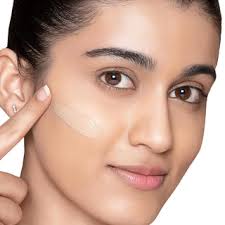How To Know Your Skin Type For Foundation

The Ultimate Guide to Choosing the Right Foundation for Your Skin Type.
 In order to find your ideal match, you must first understand your skin type and choose a foundation that best complements it. Luckily, we’ve got you covered with the following guide. Below, we’ll help you navigate through the variety of options available and find the best foundation for your unique skin needs!
In order to find your ideal match, you must first understand your skin type and choose a foundation that best complements it. Luckily, we’ve got you covered with the following guide. Below, we’ll help you navigate through the variety of options available and find the best foundation for your unique skin needs!
To find your best formula
Determine your skin type: First things first: in order to find a foundation that works best on you, you’ll need to consider your natural skin and determine what type of skin you have.
Skin usually falls into five main categories: normal, oily, dry, combination or sensitive. Normal skin is generally well-balanced, neither overly dry nor overly oily. Oily skin tends to have a glossy finish and often comes with more pronounced pores. Dry skin has the tendency to feel tight and show signs of flakiness or rough patches. Combination skin exhibits characteristics of both oily and dry skin, often with an oily T-zone and a drier cheek region. If you have sensitive skin, your skin reacts easily, often with redness or irritation.
combination or sensitive. Normal skin is generally well-balanced, neither overly dry nor overly oily. Oily skin tends to have a glossy finish and often comes with more pronounced pores. Dry skin has the tendency to feel tight and show signs of flakiness or rough patches. Combination skin exhibits characteristics of both oily and dry skin, often with an oily T-zone and a drier cheek region. If you have sensitive skin, your skin reacts easily, often with redness or irritation.
To get a good idea of your own skin type, start by washing your face with a gentle cleanser. Once finishes, leave your skin product-free for a few hours and evaluate how it feels. Does your skin become shiny (oily), feel stretched (dry), have both shiny and tight areas (combination), show redness (sensitive), or remain comfortable (normal)?
Foundations for your skin type

Oily Skin: For oily skin, look for oil-free, mattifying foundations that offer a long-lasting, shine-free finish. Products labelled “non-comedogenic” are ideal as they won’t clog your pores.
Powder foundations or liquid-to-powder formulas work well to absorb excess oil and maintain a matte finish.
Dry Skin: Moisturizing foundations that provide hydration and a dewy finish are best for dry skin. Look for terms like “hydrating,” “moisture-rich,” and “luminous” on labels. Liquid and stick foundations with a creamy consistency can offer the necessary moisture and coverage.
Combination Skin: Combination skin can benefit from a balanced foundation that’s neither too drying nor too oily. Consider using a mattifying foundation on oily areas and a hydrating formula on dry patches. Some brands offer foundations specifically designed for combination skin.
Some brands offer foundations specifically designed for combination skin.
Sensitive Skin: Choose hypoallergenic and fragrance-free foundations to minimise the risk of irritation. Mineral foundations are often a good choice as they contain fewer irritants and provide natural coverage.
Normal Skin: With normal skin, you have the freedom to try various types of foundations. However, it’s still best to choose one that enhances your natural complexion and offers the desired level of coverage.
Coverage Needs: Foundation comes in various coverage options to suit different skin needs and preferences. Sheer or light coverage provides a natural look, subtly evening out skin tone without masking it, ideal for those with fewer blemishes. Medium coverage is more adept at covering imperfections and discoloration while still allowing some natural skin features to show through.
Full coverage offers the highest level of pigmentation, concealing most blemishes, hyperpigmentation, and scars for a smooth, uniform appearance. Ultimately, the right choice depends on your desired finish and the amount of correction or enhancement you seek for your skin.
To find your best shade
Find your undertones: To determine your undertones, look at the veins on the underside of your wrist: greenish veins indicate warm undertones and blue or purple veins suggest cool undertones. If you’re finding it hard to tell if your veins are greenish or blue, you likely have neutral undertones. You can also see how certain colours make your skin appear; cool tones enhance cool undertones, while warm tones flatter warm undertones. Neutral undertones mean both cool and warm colours look good on you.
Shade Matching: Swatch potential shades on your jawline, the area where your face naturally meets your neck. The perfect shade should blend invisibly into your skin without creating any lines or contrast.  Always conduct this test in daylight, as it offers the truest representation of the foundation’s colour. Through this process, you’ll achieve a natural, flawless match that enhances your complexion.
Always conduct this test in daylight, as it offers the truest representation of the foundation’s colour. Through this process, you’ll achieve a natural, flawless match that enhances your complexion.
Selecting the ideal foundation is a tailored process that varies with each individual’s skin type, issues, and tastes. By getting to know your skin and its requirements, you’re able to choose a foundation that not only appears stunning but also provides comfort and longevity. Investing time in exploring and experimenting to discover the foundation that helps you achieve your most beautiful, confident self will always be bold .
Enhance Your Radiance With RSBeauty .
 Finding the perfect foundation is essential for creating a flawless makeup look. A good foundation will enhance your natural beauty, seamlessly evening out your complexion, concealing any blemishes or imperfections and revealing a smooth canvas from which to build upon.
Finding the perfect foundation is essential for creating a flawless makeup look. A good foundation will enhance your natural beauty, seamlessly evening out your complexion, concealing any blemishes or imperfections and revealing a smooth canvas from which to build upon.